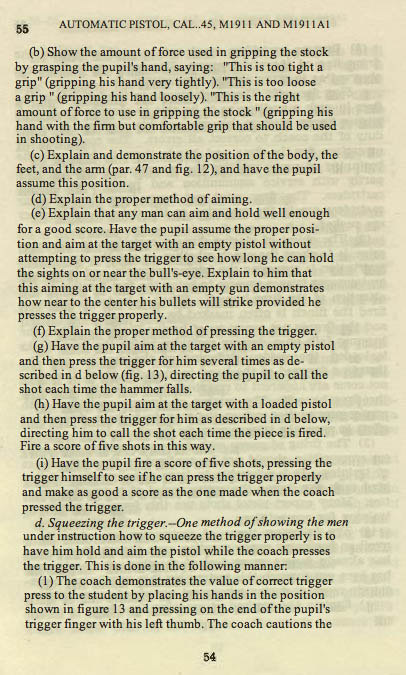Please Note: The Webmaster does not own any of the guns portrayed in the Gallery.
This is a collection of pictures from a variety of sources. The Sight M1911 does not deal in firearms.
Click on Icon for Larger View
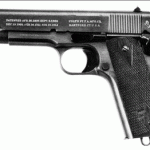
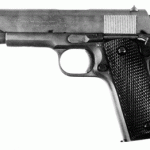
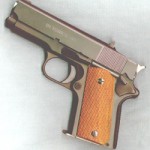
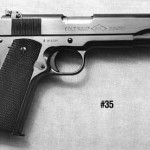
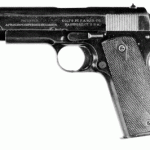
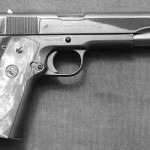
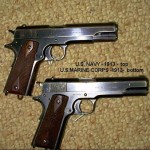
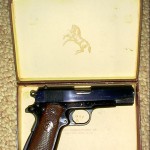
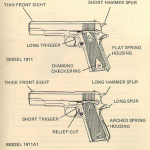
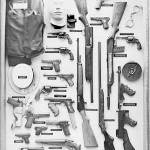
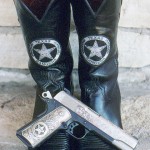
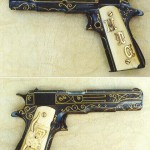
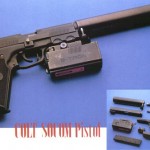
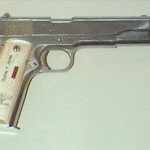
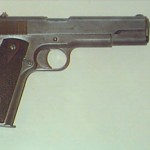
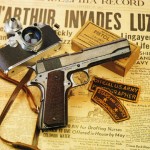
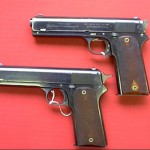
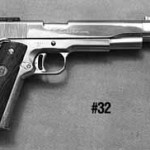
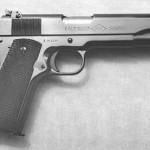
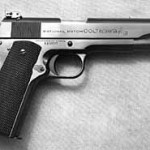
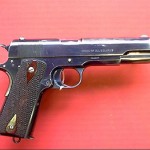
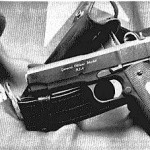
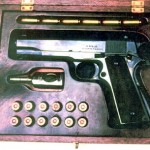
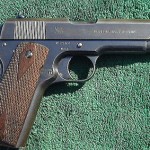
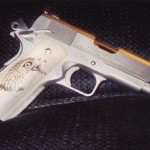
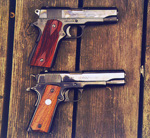
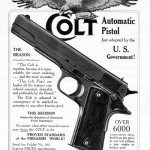
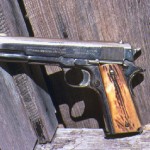
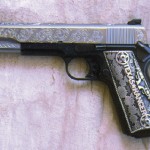
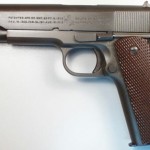
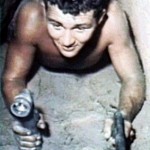
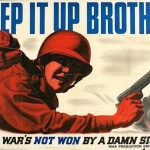
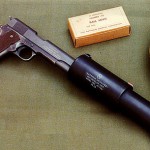
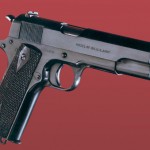
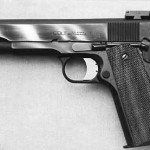
.
Keyword: 1911
Please Note: The Webmaster does not own any of the guns portrayed in the Gallery.
This is a collection of pictures from a variety of sources. The Sight M1911 does not deal in firearms.
Click on Icon for Larger View



































.
AUTOMATIC PISTOL, CAL..45, M1911 AND M1911A1 d. Small-bore targets.-No specific targets are prescribed for small-bore practice with the pistol and any suitable targets may be used. As the targets specified In the table in section V below are not available, the following targets issued by the Ordnance Department are suitable and may be used: RIfie-SB-A-2, SB-A-3, and SB-B-5.
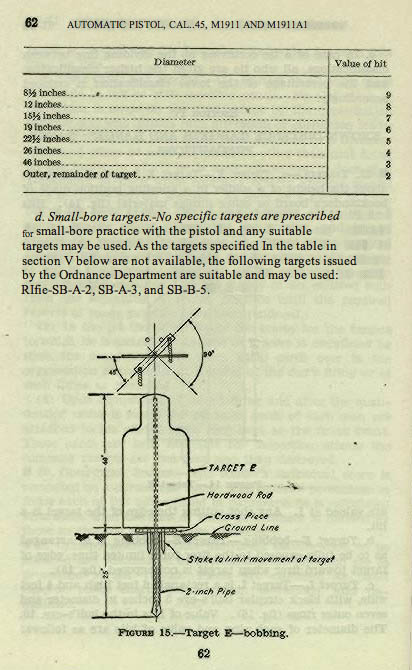
AUTOMATIC PISTOL, CAL..45, M1911 AND M1911A1 b. In case of a tie occurring at the dividing line between classifications, all who tie are given the higher classification and the percentage of the lower classification is reduced accordingly. SECTION IV KNOWN-DISTANCE TARGETS AND RANGES: RANGE PRECAUTIONS • 62. Targets.-a. Target E.-Target E is a drab silhouette about the height of a soldier in a kneeling position made of bookbinder’s board or other similar material (fig. 14). Hits are valued at 1. Any shot cutting the edge of the target is a hit. b. Target E-bobbing.-Target E–bobbing is so arranged as to be fully exposed to the firer for a limited time, edge of target toward firer when target is not exposed (fig. 15). c. Target L.-Target L is a rectangle 6 feet high and 4 feet wide, with black circular bull’s-eye 5 inches in diameter and seven outer rings (fig. 16). Value of hits in the bull’s-eye, 10. The diameter of each ring and value of hits are as follows:
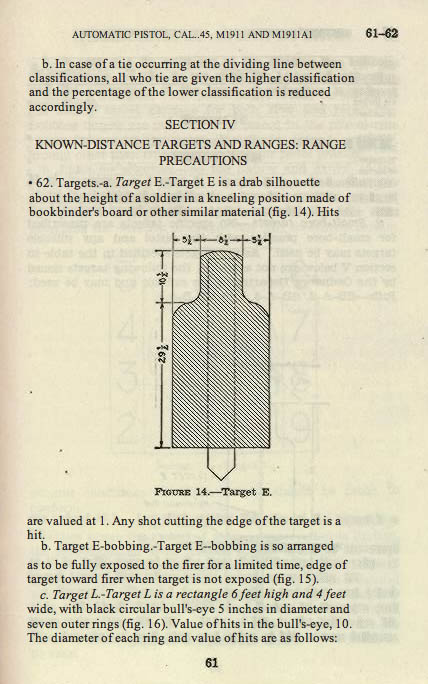
AUTOMATIC PISTOL, CAL..45, M1911 AND M1911A1 target is marked and the fixer given that value for each shot fixed by him. q. Score cards and scoring.m(1) Entries on all score cards are made in ink or with indelible pencil. No alteration or correction is made on the card except by the organization commander, who initials each alteration or correction made. (9.) The scores at each firing point are kept by a noncom- missioned officer of some organization other than that firing on the target to which he is assigned, except in case of a 1-company garrison when company officers exercise special care to insure correct scoring. As soon as a score is com- pleted the score card is signed by the scorer, taken up and signed by the officer supervising the scoring, and turned over to the organization commander. Except when required for entering new scores on the range, score cards are re- tained in the personal possession of the organization com- mander and not allowed in the hands of an enlisted man from the beginning of record practice until the required reports of range practice have been rendered. (3) In the pit the officer keeps the scores for the targets to which he is assigned. As soon as a score is completed he signs the score card. He turns these cards over to the organization commander at the end of the day’s firing or at such times as requested. (4) Upon completion of record fixing and after the quail- fication order is issued the pit score cards of each man are attached to his official score card kept at the fixing point. These cards are kept available for inspection among the company records for one year and then destroyed. • 60. Computing Scores.-The soldier’s individual score is computed on a percentage basis. The soldier’s percentage in firing each of the tables listed in paragraph 54 is calculated separately, then the sum of these percentages is divided by three to give the final average percentage. • 61. Classification.-a. The individual classification to be attained and the method of determining qualification are as prescribed in AR 775-10. Firers are classified as pistol experts, pistol sharpshooters, pistol marksmen, and un- qualified.
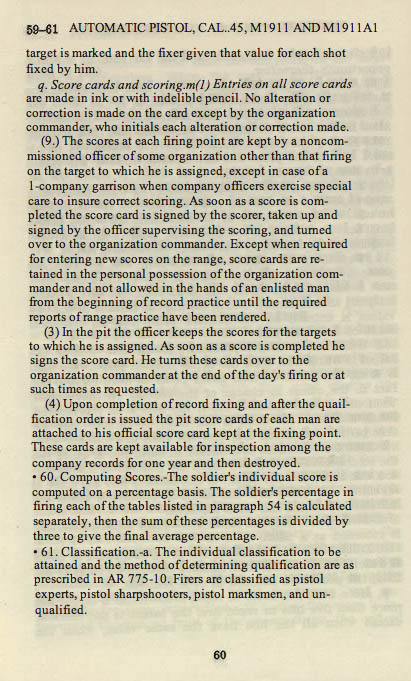
AUTOMATIC PISTOL, CAL..45, M1911 AND M1911A1 shots necessary to complete the score are fired at the first opportunity thereafter. h. Misses.-In all firing before any miss is recorded _the target is carefully examined by an officer. i. Accidental discharges,.-All shots fired by the soldier after he has taken his place on the firing line (and it is his turn to fire, the target being ready) are considered in his score even if his piece was not directed toward the target or is accidentally discharged. j. Firing on wrong target.-Snots fired upon the wrong target are entered as misses upon the score of the man firing no matter what the value of the hits upon the wrong target may be: In rapid fire the soldier at fault is credited with only such hits as he may have made on his own target. k. Two shots on same target.-In slow fire, if two shots strike a target at the same time or nearly the same time, and If one of these shots was fired from the firing point assigned to that target, the hit having the highest of the two values is entered on the soldier’s score and no record is made of the other hit. l. Withdrawing target prematurely.-In slow fire, if the target Is withdrawn from the firing position Just as the shot Is fired, the scorer at that firing point at once reports the fact to the officer in charge of the scoring on that target. That officer investigates to see if the case is as represented. Being satisfied that such is the case, he directs that the shot be not considered and that the man fire another shot. m. Missfires.-In case of a misfire in rapid fire or quick fire the soldier ceases firing and takes the position of raised pis- tol. In rapid fire the target Is not marked and the score Is repeated. In quick fire the score is continued after the defective cartridge has been replaced. n. Unused cartridges in rapid fire.-Each unfired cartridge is recorded as a miss. o. Disabled pistol.-If during the firing of a rapid or quick fire score, the pistol becomes disabled through no fault of the firer, the procedure outlined in m is followed. p. More than five shots in rapid fire.-When a target has more than five hits in rapid fire, the target is not marked, except when all the hits have the same value, when the
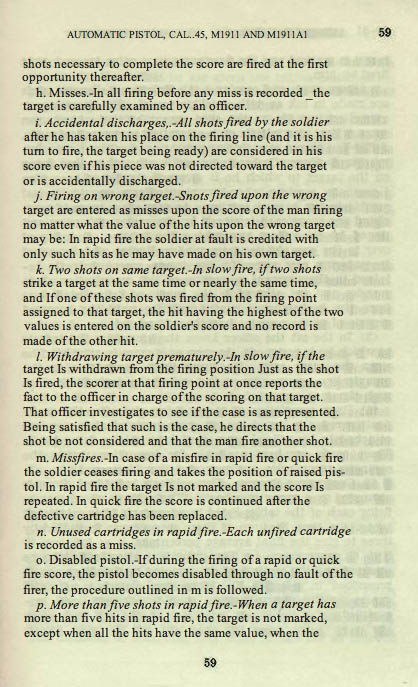
AUTOMATIC PISTOL, CAL..45, M1911 AND M1911A1 from an organization other than the one firing on the target which he supervises. When the post is garrisoned by a single company so that it is impossible to detail noncommis- sioned officers of other companies to supervise the marking and scoring, those duties are performed by the noncommis- sioned officers of the firing company. c. One or two privates to operate, mark, and paste each target. d. When the targets are not placed in pits, target details may be reduced to one commissioned officer for each four targets, one noncommissioned officer for not to exceed each two targets, and one private to each target. e. The noncommissioned officer examines the target after each score is fired and enters the score on the score card, Initialing same. He directs the private to paste the target after the score is recorded and marked and examines the target to see that no shot holes are left unpasted. 59. Regulations Governing Record Practice.-a. Coaching prohibited.-Coaching of any nature, after the firer takes his place on the firing point, is prohibited No person may render or attempt to render the firer any assistance whatever while he Is taking his position or after he has taken his position at the firing point. Each firer must observe the location of his own hits. b. Shelter for firer.–Sheds or shelter for the firer are not permitted on any range. c. Cleaning.-Cleaning is permitted only between scores. d. Gloves.-A glove may be worn on either or both hands. e. Pieces loaded on command-Pieces are not loaded ex- cept by command or until position for firing has been taken. f. Shots cutting edge of bull’s-eye or line.-Any shot cut- ting the edge of the figure or bull’s-eye is signaled and re- corded as a hit in the figure or the bull’s-eye. Because the limiting line of each division of the target Is the outer ,edge of the line separating it from the exterior division, a shot touching this line is signaled and recorded as a hit in the higher division. g. Slow fire score interrupted.-If a slow tire score is in- terrupted through no fault of the person firing the unfired
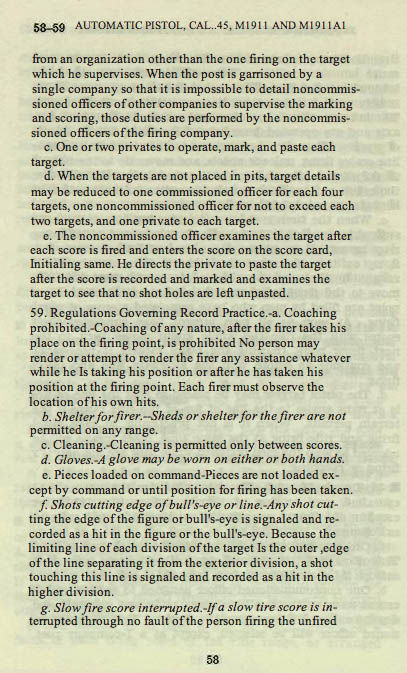
AUTOMATIC PISTOL, CAL..45, M1911 AND M1911A1 that the firing points of the rifle range and of the pistol range are on one line. There should be about 50 yards interval between the rifle range and the pistol range. The targets may be placed on the ground instead of in pits. The bobbing targets are arranged to revolve on their own axis and are operated from behind the firing line by means of cords. When the targets are to be marked the whole line ceases firing, unloads pistols, and moves up to the targets to record the hits and paste the shot holes. In slow fire the coach can keep the firer informed as to the location of his hits by use of field glasses. c. When the time is short and range facilities and proper supervision permit, rifle firing and dismounted pistol firing may be carried on at the same time. While one group is firing on the rifle range the other is firing on the pistol range. As the men complete a score with the rifle they move to the pistol range and their places at the rifle firing point are Riled by men who have completed a score of pistol firing. As soon as all men present have completed their scores with the rifle the whole group moves back to the next firing point (moving the pistol targets if necessary) and continue as before with the alternate rifle and pistol firing. d. The pistol targets may be placed so that the line of fire is at right angles to the line of fire of the rifle range if the terrain permits. When it is not practicable to have pistol firing and rifle firing at the same time, other means will be adopted to keep the men occupied while they are not actually firing or coaching. • 58. TARGET Details.-The personnel for the supervision, operation, and scoring of targets during recorded firing consists of officers, noncommissioned officers, and privates as follows: a. One commissioned officer assigned to each four targets. The officer will take up and sign each duplicate score card as soon as a complete score is recorded. b. One noncommissioned officer assigned to each target to enter scores on the duplicate score cards and to direct and supervise the detail pasting the target. This noncommis- sioned officer will be select except at a 1-company post,
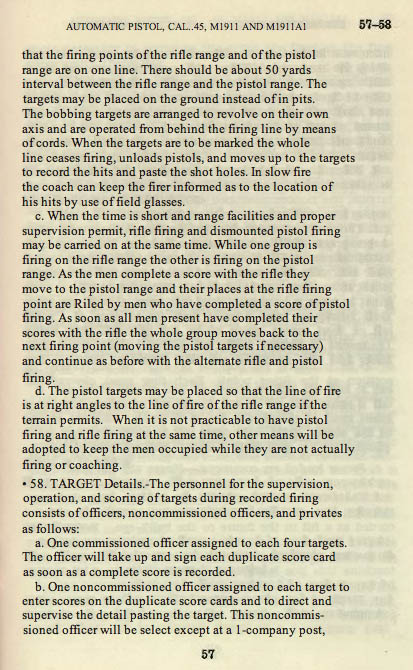
AUTOMATIC PISTOL, CAL..45, M1911 AND M1911A1 magazine in such a way that the firer cannot know the order in which the cartridges are placed. (2) The coach must watch the man closely, and each time he is seen to flinch, whether on a loaded or a dummy car- tridge, the coach should caution him. (3) When the hammer falls on a dummy cartridge the firer grasps the slide with his left hand, pulls it fully back. and releases it. This ejects the dummy and loads another cartridge. The time limit must be extended to compensate for the time lost in ejecting the dummy cartridges. It should not take more than 2 seconds to eject a dummy cartridge and resume the aiming position. g. Coaching quick fire.–(1) The use of dummy cartridges and the coaching methods are the same in quick fire as in rapid fire. (2) The occasional use of dummy cartridges in both rapid fire and quick fire should be continued throughout the entire period of instruction practice. • 56. Safety Precautions on the range.-a Never place a loaded magazine in the pistol until you have taken your place at the firing point. b. Always remove the magazine and unload the pistol before leaving the firing point. c. Always hold the loaded pistol at the position of raise pistol except while aiming. d. When firing ceases temporarily, lock the piece and hold it at raise pistol DO not assume any position except raise pistol without first removing the magazine and unloading. e. If one or more cartridges remain unfired at the end of a rapid-fire or quick-fire score, remove the magazine and unload immediately. 57. Range organization.-a. The work on the range should be so organized that no men are idle for any length of time. A good arrangement is four or six orders per target. It should never be necessary to assign more than six orders. If there is not a sufficient number of targets to provide for this, the extra men should remain off the range and be given other instruction. b. One method is to have a line of pistol targets on a flank of each firing point of the rifle range, so arranged
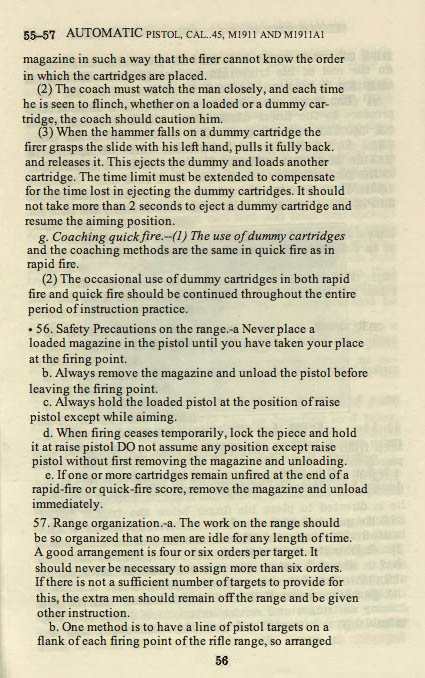
AUTOMATIC PISTOL, CAL..45, M1911 AND M1911A1 pupil neither to assist nor resist the pressure which is put on the end of his trigger finger but to devote his whole attention to his aim and hold. (2) The coach must be careful to apply a slow, steady pressure to the finger of the pupil and at the same time not interfere with the pupil’s aim while applying this pres- sure. As a rule, the coach should consume from § to 10 seconds in putting sufficient pressure on the pupil’s finger to fire the pistol. (3) When pressing the trigger for a pupil as above de- scribed the coach should hold his head well to the rear to keep from having his left ear too near the muzzle of the piece. (4) If the firer shows a tendency to apply the last part of the squeeze himself by giving the trigger a sudden pressure, he is directed to place his finger below the trigger guard, and the coach applies the pressure directly to the trigger instead of through the finger of the man under instruction. e. Calling the shot.-Men should be required to call each shot in slow fire. If a man does not call the shot immedi- ately after firing, the coach directs him to do so. f. Coaching rapid fire.-(1) The firing of scores with dummy cartridges and service ammunition mixed is a very valuable form of rapid-fire practice. The coach fills the
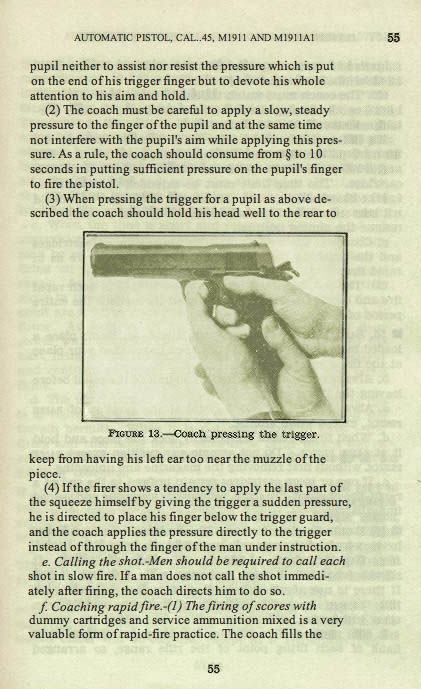
AUTOMATIC PISTOL, CAL..45, M1911 AND M1911A1 (b) Show the amount of force used in gripping the stock by grasping the pupil’s hand, saying: “This is too tight a grip” (gripping his hand very tightly). “This is too loose a grip ” (gripping his hand loosely). “This is the right amount of force to use in gripping the stock ” (gripping his hand with the firm but comfortable grip that should be used in shooting). (c) Explain and demonstrate the position of the body, the feet, and the arm (par. 47 and fig. 12), and have the pupil assume this position. (d) Explain the proper method of aiming. (e) Explain that any man can aim and hold well enough for a good score. Have the pupil assume the proper posi- tion and aim at the target with an empty pistol without attempting to press the trigger to see how long he can hold the sights on or near the bull’s-eye. Explain to him that this aiming at the target with an empty gun demonstrates how near to the center his bullets will strike provided he presses the trigger properly. (f) Explain the proper method of pressing the trigger. (g) Have the pupil aim at the target with an empty pistol and then press the trigger for him several times as de- scribed in d below (fig. 13), directing the pupil to call the shot each time the hammer falls. (h) Have the pupil aim at the target with a loaded pistol and then press the trigger for him as described in d below, directing him to call the shot each time the piece is fired. Fire a score of five shots in this way. (i) Have the pupil fire a score of five shots, pressing the trigger himself to see if he can press the trigger properly and make as good a score as the one made when the coach pressed the trigger. d. Squeezing the trigger.–One method of showing the men under instruction how to squeeze the trigger properly is to have him hold and aim the pistol while the coach presses the trigger. This is done in the following manner: (1) The coach demonstrates the value of correct trigger press to the student by placing his hands in the position shown in figure 13 and pressing on the end of the pupil’s trigger finger with his left thumb. The coach cautions the
